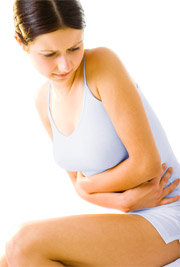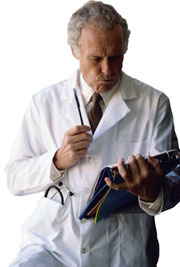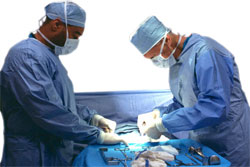- What is Endometriosis?
- Statistics
- Risk Factors
- Progression
- Symptoms
- Clinical Examination
- How is it Diagnosed
- Prognosis
- Treatment
- References
What is Endometriosis?
| Endometriosis is a condition in which endometrial tissues grow outside of the uterus and cause surrounding tissues to become inflamed. Abnormal endometrial tissue growth is most commonly found in the pelvis, however deposits may also occur at distant sites including the brain. Excessive endometrial tissues then attach to tissues in the new location (e.g. the pelvis) and form benign (i.e. non-cancerous) nodules.The condition affects women of reproductive age. Many women with endometriosis will be asymptomatic (i.e. they will not show of the symptoms associated with endometriosis) and unaware that they have endometriosis. In other cases symptoms (most commonly pain) will be quite severe and have a considerable impact on the woman’s physical, mental and/or general wellbeing. |
Statistics
Endometriosis occurs in women of reproductive age. Because women suffering from endometriosis often display no symptoms and are unaware of their condition, it is difficult to determine exactly what proportion of women develop endometriosis. Estimates suggest however, that 5-10% of women of reproductive age experience endometriosis, and the risk of developing the condition increases as a woman gets older.
Risk Factors

Menstruation is also believed to provide the route by which endometrial cells leave the uterine cavity as part of menstrual blood. Once these tissues have left the uterus, they have the opportunity to adhere to other tissues (e.g. pelvic organ tissues) and form endometrial deposits. While the body’s immune system should initiate a response to stop the endometrial tissues adhering to sites outside the uterus, it is thought that this response sometimes fails, thus enabling endometrial tissues to adhere and form deposits.
A range of lifestyle factors which affect the body’s oestrogen levels also appear to influence the development of endometriosis. These include:
- Levels of exercise (individuals with low levels of physical activity are more likely to develop endometriosis);
- Tobacco consumption (consuming tobacco increases the risk of endometriosis);
- Body Mass Index (individuals who are overweight or obese are more likely to develop endometriosis than those who are not)
This information will be collected for educational purposes, however it will remain anonymous.
Progression
Little is known about the natural progression of endometriosis, as studying the course of the disease requires performing a laparoscopic investigation on multiple occasions. It appears however, that once endometrial cells leave the uterine cavity via menstrual blood, they adhere to other tissues and form deposits. These deposits often continue to grow and endometrial cells can break away from existing deposits, attach to new sites and form new deposits.
Evidence from scientific studies suggests that when left untreated, endometriosis resolves naturally in around one third of women in 6-12 months and remains changed in almost 20%. However endometriosis will progress (i.e. the deposits will grow larger, and/or additional deposits will form) in about half of all cases.
Symptoms

- Dysmenorrhoea (pain during menstruation)
- Pelvic pain
- Infertility (the inability to become pregnant) or subfertility (a reduced ability to become pregnant)
- Dyspareunia (painful intercourse)
- Dyschezia (painful defecation)
- Lower abdominal pain
- Back pain
- Loin pain
- Pain on micturition (urination)
- Pain on exercise.
Clinical Examination
Patients presenting to a health practitioner with symptoms of endometriosis are likely to be asked a range of questions about their reproductive history and menstrual cycles. Practitioners will probably be interested to know when the symptoms of endometriosis occur and if they are generally experienced at the time of menstruation.
It is also likely that a doctor will perform a pelvic examination to identify areas that are tender, have an unusual appearance or have attached deposits. It is easiest for a doctor to identify the signs of endometriosis when a woman is menstruating, so patients may be asked to come back to the doctor once their periods begin. In some cases a rectal (anal) examination will also be performed.
How is it Diagnosed

Prognosis
Pharmacological treatments can provide short term pain relief, however do not reduce endometrial growth. While laparoscopic surgery is quite effective in removing endometrial deposits, reducing pain and increasing fertility, it is common for endometriosis to recur following surgery. Endometriosis recurs in 20-50% of cases within five years of treatment.
Treatment
Treatment of endometriosis can be either by medication or surgery.
Medication treatments

- Combined oral contraceptive pills: these regulate the menstrual cycle when taken conventionally (e.g. as a monthly cycle containing seven sugar pills which are consumed during menstruation) and can suppress menstruation when taken continuously (i.e. when the sugar pills are excluded and hormone containing pills taken continuously);
- Progesterone only contraceptive pills: these regulate the menstrual cycle in a similar manner to combined contraceptive pills);
- Gonadotrophin-releasing hormone antagonists: these reduce oestrogen levels and offer effective relief for pain associated with endometriosis;
- Synthetic androgen: this can reduce oestrogen and increase androgen levels and is effective in relieving pain associated with endometriosis. It has a number of side effects however and is suitable only for short term symptom relief.
For women who present with pain symptoms, it is common for medication therapies to be prescribed as the first type of treatment. When these fail in women with pain symptoms, or for women presenting with infertility and signs of endometriosis, a doctor will usually recommend laparoscopic investigation and surgery if endometriosis is diagnosed.
Surgical treatments

In severe cases, more radical surgery may be necessary. Hysterectomy is sometimes performed in women who do not want to have any more children.
Other treatments
Other treatments which may provide effective treatment for symptoms associated with endometriosis include:
- Intrauterine devices: a device known as the Levonorgestral Intrauterine System, which reduces menstrual bleeding, can provide relief of pain associated with endometriosis for up to three years;
- Flushing fallopian tubes: with oil soluble fluid can increase fertility rates amongst women with endometriosis, however little is known about how and why tubal flushing is effective;
- Complementary therapy: many patients report a benefit from complementary therapies (e.g. reflexology, herbal treatments), however the impact of complementary therapies has not been formally assessed. It is therefore unclear whether such therapies reduce endometrial tissue growth or symptoms, or simply have a psychological effect which enables patients to cope with the symptoms of endometriosis better
References
- Royal College of Obstetricians and Gynaecologists. The Investigation and Management of Endometriosis. Green Top Guideline No. 24. 2006. [cited 2010, October 15]. [URL Link]
- Farqhuar C, Endometriosis: Clinical Review. BMJ. 2007; 334: 249-53. [Abstract]
- Pugsley Z, Ballard K. Management of Endometriosis in General Practice: the pathway to diagnosis. Brit J Gen Prac. 2007; 57: 470-476. [Abstract]
- Hooghe T, Debrock S. Endometriosis, retrograde menstruation and peritonaeal inflammation in women and baboons. Human Repro Update. 2002; 8(1): 84-88. [Full Text]
- Prentice A. Endometriosis. BMJ. 2001. 323:93-5. [Abstract]
- El Mowafi DM. Laparoscopic management of endometriosis. Geneva Foundation for Medical Education and Research. 2006. [cited 2010, October 15]. [URL Link]
- National Breast Cancer Centre, Assessment of Symptoms that may be Ovarian Cancer: a Guide for GPs. 2005. [cited 2010, October 15]. [URL Link]
- Dimetriose- Consumer Medicine Information. Lane Cove. NSW: Aventis Pharma Pty Ltd. February 2001. [cited 2010, October 15]. [URL Link]
- Prentice A, Deary AJ, Bland E. Progestagens and anti-progestagens for pain relief associated with endometriosis. Cochrane Database Syst Rev. 2000; 2: CD002122. [URL Link]
- Zoladex- Consumer Medicine Information. North Ryde. NSW: AstraZeneca Pty Ltd. July 2003. [cited 2010, October 15]. [URL Link]
- Sagsveen M, Farmer JE, Prentice A, Breeze A. Gonadotrophin-releasing hormone analogues for endometriosis: bone mineral density. Cochrane Database Syst Rev. 2003; 4. Art. No.: CD001297. [cited 2010, October 15]. [Abstract]
- Azol- Consumer Medicine Information. Glebe. NSW: AlphaPharm Pty Ltd. 10 May 2005. [URL Link]
- Selak V, Farquhar C, Prentice A, Singla A. Danazol for pelvic pain associated with endometriosis. Cochrane Database Syst Rev. 2007; Issue 2. Art. No.: CD000068. [cited 2010, October 15]. [Abstract]
- Lockhat FB, Emembolu JO, Konje JC.The efficacy, side effects and continuation rates in women with symptomatic endometriosis undergoing treatment with an intra-uterine administered progestogen (levonorgestrel): a 3 year follow-up. Hum Reprod. 2005; 20: 789-93. [cited 2010, October 15]. [Abstract | Full Text]
- Johnson NP, Vandekerckhove P, Watson A, Lilford R, Harada T, Hughes E. Tubal flushing for subfertility. Cochrane Database Syst Rev. 2005; (2): CD003718. [cited 2010, October 15]. [Abstract]
All content and media on the HealthEngine Blog is created and published online for informational purposes only. It is not intended to be a substitute for professional medical advice and should not be relied on as health or personal advice. Always seek the guidance of your doctor or other qualified health professional with any questions you may have regarding your health or a medical condition. Never disregard the advice of a medical professional, or delay in seeking it because of something you have read on this Website. If you think you may have a medical emergency, call your doctor, go to the nearest hospital emergency department, or call the emergency services immediately.







